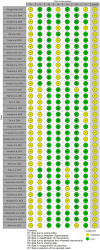Cerebrospinal fluid and serum biomarkers in idiopathic intracranial hypertension: A systematic review
- PMID: 40781762
- PMCID: PMC12455426
- DOI: 10.1111/head.15023
Cerebrospinal fluid and serum biomarkers in idiopathic intracranial hypertension: A systematic review
Abstract
Objective: This study aimed to systematically review the literature on soluble biomarkers in adults with idiopathic intracranial hypertension (IIH).
Background: Idiopathic intracranial hypertension is a multifactorial disorder marked by elevated intracranial pressure without a clear cause. Although it primarily affects overweight women of reproductive age, its pathogenesis remains incompletely understood. Symptoms include headache and visual disturbances due to papilledema. Increasing attention has focused on soluble biomarkers in serum and to understand disease mechanisms and aid diagnosis and management.
Methods: This systematic review was conducted in accordance with Preferred Reporting Items for Systematic Reviews and Meta-Analyses guidelines and registered in PROSPERO (CRD420250630653). The systematic literature search was conducted across PubMed, Web of Science, and Scopus for studies published in English between January 1995 and December 2024. Articles investigating cerebrospinal fluid (CSF) and/or blood biomarkers in adult patients with IIH were included. Multiple reviewers independently conducted screening, data extraction, and quality assessment. The risk of bias was evaluated using the ROBINS-I tool.
Results: A total of 38 studies on serum/plasma, urine, and CSF biomarkers met the inclusion criteria. The identified biomarkers were categorized into five main groups: (1) metabolic/endocrine, (2) systemic and neurogenic inflammation, (3) neurodegeneration, (4) neural antibodies and CSF dynamics, and (5) miscellaneous. Consistently elevated leptin levels were reported across studies, alongside evidence of cortisol dysregulation, altered androgen profiles, and insulin resistance. Inflammatory markers were frequently elevated, indicating a state of low-grade systemic inflammation; however, findings regarding specific inflammatory markers were variable and lacked consistency. Two studies evaluated calcitonin gene-related peptide (CGRP) in plasma, finding elevated levels in IIH, especially in those with migraine-like headache. Neuronal markers like neurofilament light chain (NfL) were increased and correlated with disease severity. Emerging candidates included microRNAs, metabolites identified through metabolomic approaches, and novel proteins discovered via proteomic analyses.
Conclusions: IIH appears to involve interplay of inflammatory, metabolic, and neurodegenerative processes. Although androgen dysregulation, leptin, and NfL show the most consistent association, substantial heterogeneity in study methods and populations limits generalizability. CGRP may emerge as a promising biomarker reflecting the predominant clinical symptom-headache-potentially guiding future therapeutic strategies.
Keywords: calcitonin gene‐related peptide; headache; idiopathic intracranial hypertension; papilledema; pseudotumor cerebri.
© 2025 The Author(s). Headache: The Journal of Head and Face Pain published by Wiley Periodicals LLC on behalf of American Headache Society.
Conflict of interest statement
Figures
References
-
- Wang MTM, Bhatti MT, Danesh‐Meyer HV. Idiopathic intracranial hypertension: pathophysiology, diagnosis and management. J Clin Neurosci. 2022;95:172‐179. - PubMed
-
- Wang M, Zhou P, Zhang S, et al. Clinical features, radiologic findings, and treatment of pediatric germ cell tumors involving the basal ganglia and thalamus: a retrospective series of 15 cases at a single center. Childs Nerv Syst. 2018;34(3):423‐430. - PubMed
Publication types
MeSH terms
Substances
LinkOut - more resources
Full Text Sources
Research Materials
Miscellaneous



